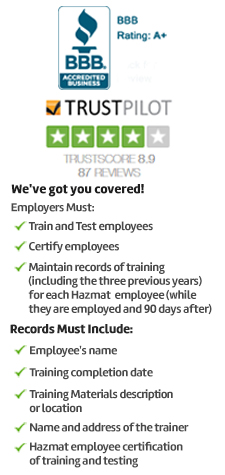_Inner_banner.jpg)
DOT HAZMAT Shipping Training

Students joining this course get to know the U.S. Department of Transportation (DOT) Hazardous Materials Regulations with respect to shipping hazardous consignments through sea. The course has been formulated to include all basic concepts of safety procedures including safe handling and transport regulations and process to identify, handle, pack, and carry various kinds of hazardous materials via sea ports and vessels.
Students are provided with the information on the International Maritime Dangerous Goods Code and its relevance while carrying hazardous materials via ships along with understanding on the safety needs as stated in section 171.12 and 176.11 of the HMR.
Who must take this course?
According to 49 CFR part 176 section 13 Responsibility for compliance and training, a sea carrier will not be allowed to transport hazardous materials unless each of their workers involved in handling and transportation should be properly trained as mentioned by subpart H of part 172 of this subchapter.
How long is the course?
This is a short term course having a minimum duration of 2 hours. However, students can complete this course as per their work and academic schedule. As this is an online course, students can log on and off as per their time constraint. When they log off, they can create a bookmark to be resumed from where they left when they log in again.
How soon is the certificate of completion issued?
Once they complete the course successfully, participants gets immediate access to a printable DOT Hazmat Transportation – Carrier Requirements (Water) training certificate and wallet card.
How long do I have to complete this course?
Students can take their own time to complete the course as per their work and academic compulsions. There is no restriction on them to complete the course within the scheduled time. Also, you can buy courses for others and assign them as per the convenience. We have an attractive bulk purchase discounts in which you can buy a large number of courses at lower price and utilise them later.
Continuing education credits?
Each student will receive 0.2 CEUs (or 2 CMEs) from Compliance Training Online® after completing the safety course.
Course Format
Our DOT Hazmat Transportation – Carrier Requirements (Water) training course contains good quality content, graphics and audio presentations and question banks to practice well to clear the final exam.
Course synopsis
This course has been conceptualised to create awareness among workers and handlers of hazardous materials at sea ports and ships on the safety measures and risks involved in loading, unloading, and special safety procedures and regulations with regard to hazardous goods movements for sea transport. The course aims to make hazmat employees knowledgeable about different hazardous items, risks and dangers in handling them, and existing regulations while transporting such materials by vessel. Tutors also provide statistics and case studies to make students understand various hazardous materials compliances with regard to vessel transportation.
How often is retraining or recertification required?
According to the DOT, each hazardous material worker should be subjected to training to update his/her knowledge and skills at least once in three years.
Topics Covered
- About This Course
- Course Objectives
- Introduction to DOT Hazmat Carrier Vessel Training Course
- Applicability
- Key Terms
- Incidents and Statistics
- Hazardous Materials Regulations (HMR)
- Regulatory Agencies
- Training Requirements
- Hazardous Materials Table (HMT)
- Columns 1-10 of the HMT
- Appendix A
- Appendix B
- How to Use the HMT
- Hazard Classes
- ORM-D
- 49 CFR Part 176: Subparts A and B
- Subpart A—General Requirements
- Vessel Personnel
- Inspection
- Subpart B—General Operating Requirements
- Shipping Papers
- Certificates
- Dangerous Cargo Manifest
- Other Documentation
- Inspection of Cargo
- Subpart A—General Requirements
- Subparts C and D
- Subpart C—Handling and Stowage Requirements
- Preparation of the Vessel
- General Stowage Requirements for Hazmat
- Transport Vehicles, Freight Containers, Portable Tanks, and Power-Operated Industrial Trucks
- Subpart D—Segregation Requirements
- Segregation Table Key
- Subpart C—Handling and Stowage Requirements
- Subparts E and F
- Subpart E—Control of Transport Vehicles
- Private Automobiles and Motorboats
- Subpart F—Special Requirements for Barges
- Subpart E—Control of Transport Vehicles
- Subpart G—Detailed Requirements for Class 1—Explosive Materials
- Loading and Unloading
- Precautions
- Stowage
- Electrical Requirements
- Segregation
- Passenger Vessels
- Cargo Transport Units and Shipborne Barges
- Handling Class 1—Explosive Materials in Port
- Magazine Vessels
- Subparts H, I, and J
- Subpart H—Detailed Requirements for Class 2—Compressed Gas Materials
- Stowage under Deck
- Miscellaneous Stowage Requirements
- Subpart I—Detailed Requirements for Class 3—Flammable and Combustible Liquids
- Miscellaneous Requirements
- Subpart J—Detailed Requirements for Class 4—Flammable Solids, Class 5—Oxidizers and Organic Peroxides, and Division 1.5 Materials
- Stowage of Charcoal
- Division 1.5 materials, Ammonium Nitrate, and Ammonium Nitrate Mixtures
- Permit Requirements
- Subpart H—Detailed Requirements for Class 2—Compressed Gas Materials
- Subparts L, M, N, and O
- Subpart L—Detailed Requirements for Division 2.3 Poisonous Gas and Division 6.1 Poisonous Materials
- Subpart M—Detailed Requirements for Radioactive Materials
- Transport and Criticality Safety Indices
- Tables
- Segregation Distances
- Leakage or Sifting of Radioactive Materials
- Subpart N—Detailed Requirements for Class 8—Corrosive Materials
- Subpart O—Detailed Requirements for Cotton and Vegetable Fibers, Motor Vehicles, Polymeric Beads, and Plastic Molding Compounds
- Stowage of Cotton or Vegetable Fibers with Rosin or Pitch
- Stowage of Cotton or Vegetable Fibers with Coal
- Stowage of Motor Vehicles and Mechanical Equipment
- Polymeric Beads and Plastic Molding Compounds
- Incident Reporting and Security
- Security Awareness
- Summary
- Additional Resources
- Exam

 NEBOSH CERTIFICATE
NEBOSH CERTIFICATE NEBOSH DIPLOMA
NEBOSH DIPLOMA IOSH
IOSH SAFETY DIPLOMA
SAFETY DIPLOMA CPD UK
CPD UK ROSPA UK
ROSPA UK FOOD SAFETY
FOOD SAFETY 



